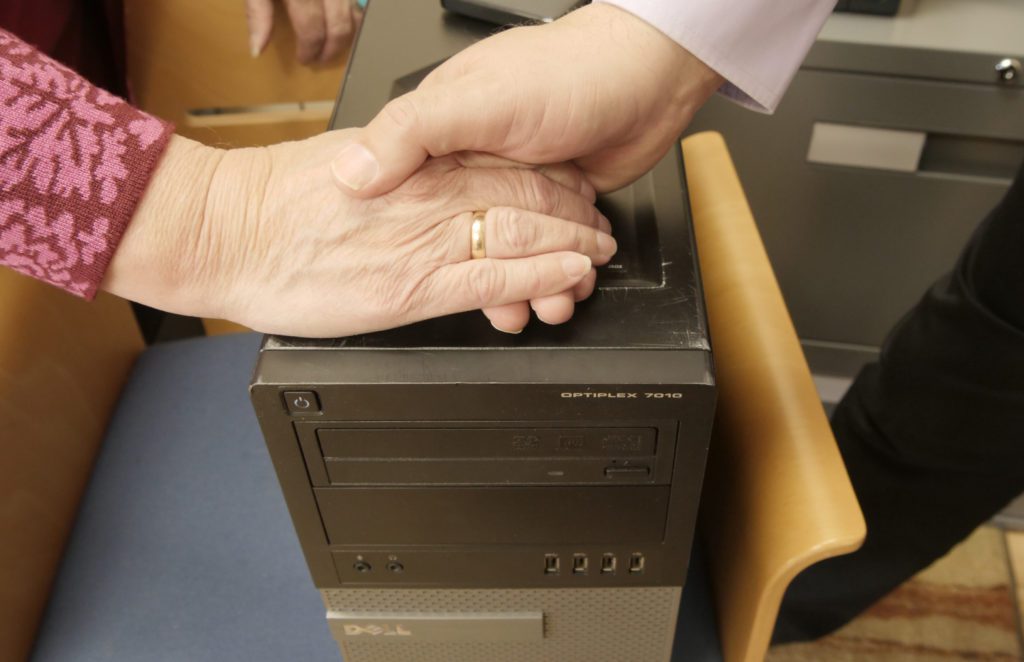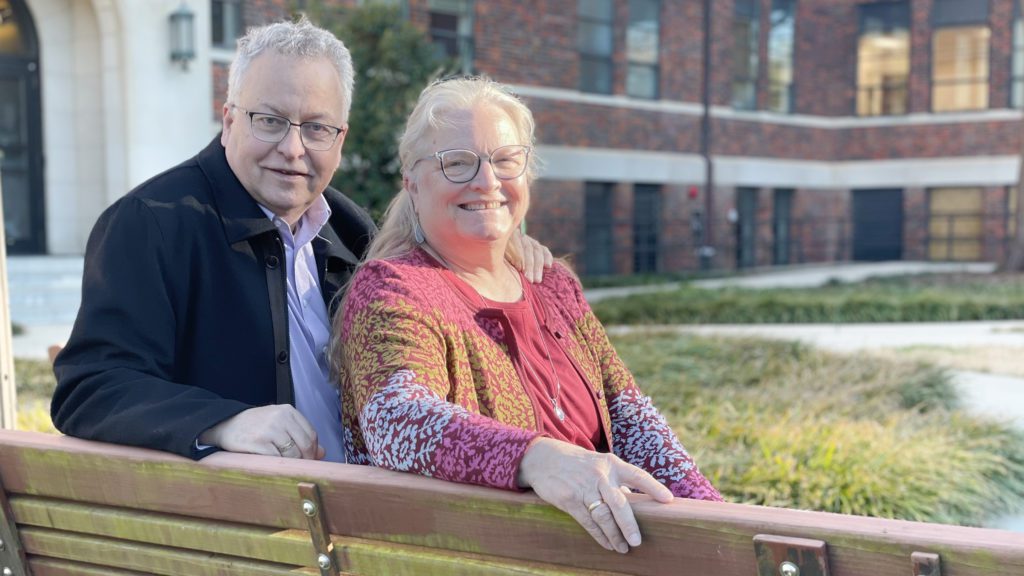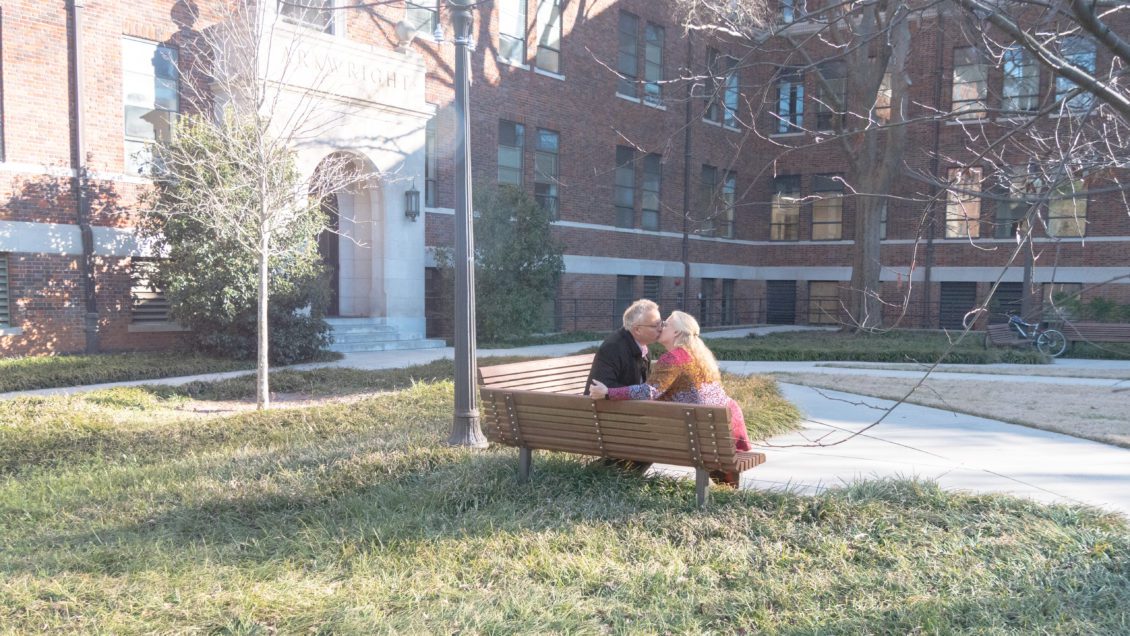Clemson University has no shortage of romantic meeting spots. President’s Park, the ’55 Exchange, Bowman Field and the Botanical Gardens have all given love a chance to take root and grow. But one special place on campus provided the spark for a love that spanned two continents and led to almost 25 years of marriage. You can find it in Sirrine Hall, in office 256E, under a desk, on a hard drive.
The story begins in 1994.
“The internet was new to us, but I had seen a reference to a place called MediaMOO,” says Jan Rune Holmevik, associate professor of English at Clemson. “It was a new frontier at the time, and I thought I would check it out.”
A MOO, which stands for “Multi-user domain, Object-Oriented,” was an early form of online virtual reality, which drew inspiration from text-based adventure games and science fiction.
“The ‘metaverse’ idea has gotten a lot of attention lately because of Facebook’s name change to ‘Meta,’” Holmevik explained, “but the term goes back to the early 90’s, and the underlying concept hasn’t changed. We were trying to build a metaverse with the technology available at the time.”
When Holmevik signed on to MediaMOO for the first time, he had just finished his master’s thesis on the history of technology and was then a researcher at the Norwegian Institute of Science and Technology in Oslo, Norway.
“It allowed you to set up your own space, and I had never experienced something like that before,” he recalled. He had only been on the network for about a day when he got an urgent message from a digital damsel in distress: Cynthia Haynes.
The idea of the ‘metaverse’ has gotten a lot of attention lately because of Facebook’s name change to ‘Meta,’ but the term goes back to the early 90’s, and the underlying concept hasn’t changed. We were trying to build a metaverse with the technology available at the time.”
Jan Rune Holmevik, Clemson University Department of English
“I had a crisis, and he happened to be online,” Haynes remembers. Holmevik introduced himself by his initials, “JR,” which Haynes misinterpreted as “Junior.”
“I was really embarrassed when he asked, ‘Why do you keep calling me “Junior?”‘” Haynes remembers. She asked his name and where he was located, both of which he revealed.
“Mind blown!” she said. “All of a sudden, it became this global thing.”
With introductions complete, their relationship quickly began to grow. Haynes, who is now director of the rhetorics, communication and information design Ph.D. program at Clemson, was about to apply for a position at the University of Texas at Dallas. For her interview, she wanted to demonstrate the use of MOO’s for teaching writing. Holmevik, who was still developing his English skills, joined remotely to assist.
Haynes got the job.
At the University of Texas at Dallas, Haynes wanted to continue her research into using online tools to teach writing to students, but MediaMOO was only open to researchers, so she and Holmevik collaborated on creating an online space of their own: LinguaMOO.
“The relationship evolved as we were beginning to collaborate,” Haynes explained. “You get to know someone really well when all you have is talking.”

The online conversations evolved to some “snail-mail” letters, an exchange of photos, then phone calls. Five months after their online meet-cute, they planned a Trans-Atlantic date in New York City.
“We had a whirlwind weekend,” Haynes recalls. “We went to the Empire State Building. We went to the Twin Towers.”
“He brought me a yellow rose because that’s the state flower of Texas,” Haynes begins, and Holmevik finishes the story. “We then went to the top of the Empire State Building and let it go in the wind.”
Holmevik had to hurry back to Norway to be back in the office at 8 a.m. the following Monday, but his heart was set. He still keeps a photo of Haynes from that trip framed on his desk.
They were married in June 1997 in Norway. They will celebrate their 25th anniversary this year.
“When people ask us how we met, and we say we met online in 1994, at first, they get through the online part, and they think ‘everybody does that,’” Haynes says. “Then they hear 1994, and they say, ‘Wait a minute, there wasn’t even a web browser then, was there?’”
Haynes and Holmevik have both made careers out of the study and development of online communication, publishing two books together: High Wired: On the Design, Use, and Theory of Educational MOOs and MOOniversity: A Student’s Guide to Online Learning.

They watched as the internet grew from curiosity to a world-changing force. Over the years, MediaMOO’s usage faded, and its database changed hands several times until it came to Haynes. It sat inaccessible on her computer for several years until she could bring it back online at Clemson. Now, it represents a piece of technology history, but it’s also a sentimental community for Haynes and Holmevik. Where they met now sits on a hard drive in Haynes’s office in Sirrine Hall.
“It’s about sharing a very important part of a community of scholars who congregated in those spaces in the ‘90s and developed really what rhetoric and composition as a field is today,” Holmevik said.
It was also the first of many pervasive technologies—online teaching, videoconferencing, texting—on which the couple was years ahead of the curve.
“The power and importance of communication in those spaces were always clear to me,” Holmevik says.
“Some people don’t see the value of online learning, but we made our careers in online learning and educational technologies in general, so it has come full circle in a way,” Haynes reflected. Then she added with a laugh, “I just wish we had bought stock in Zoom.”

Get in touch and we will connect you with the author or another expert.
Or email us at news@clemson.edu

